Hmmm… Since Monday’s a holiday (happy Columbus day everyone), no mail, no Netflix. No matter, I do have a film to review for Wednesday’s Midnight Movie Madness. Woof!
Meanwhile: the postman always shoots twice.
“The horseman” – (96 minutes, Australia 2008)
Not to be confused with “the horsemen” (USA2009)
I’m really not a fan of revenge movies, I don’t particularly care for the “Dirty Harry” series, much less “Death Wish”. You can guess by extension, that the so-called “torture porn” movies are even less my thing as far as entertainment goes.
The Australian film “the horseman” seems on the surface to fit in neatly with at least the first two, but “horseman” is more of a Western for me.
Watch the trailer:
Strange? Maybe, but would you consider “the searchers” (John Ford, 1956) a revenge movie..?
The language of Westerns is spare, and plain. Surviving in the face of great odds and hardships, natural or otherwise, dictates humility and economy.
Some films have clever dialogue and good one liners. It is telling that the imdb page for “the horseman” has no ‘memorable quotes’, not one, and that is a really good thing. This isn’t Schwarzenegger or Tarantino territory.
I will not include spoilers in this review. The premise is that a man receives news of his daughter’s death under more than questionable circumstances. We understand from the first few minutes that she was a runaway, and had taken part in some cheap, semi-underground porno.
The man (Peter Marshall) wears a pest control uniform with his name, Christian, on it. Make what you will of the occupation or the name.
When Christian finds out about the porno film, he sets out to find the people who made it and kill them. The majority of reviews call this a revenge movie, and again, I don’t see this as Christian’s motivation. Rather, I see a man needing cleansing from the filth that reached him through his daughter.
He was done and ready to go home about mid-way through the film, there was no desire to keep on killing, especially after having bonded with a runaway (Caroline Marohasy) the age of his daughter, he’d done what needed doing.
The cinematography is stark, shadows are intense and light feels at times like a harsh glint. In fact, watching Christian’s face is like watching the planes and contours of a steel hammer. Reading his expressions is noting the imperfections in the metal, Marshall’s performance is minimalist and perfectly suited and nuanced.
His violence is purposeful, as opposed to the sadism demonstrated by another later in the film. And for realism, simply keep in mind a scene involving a handcuffs’ key, and later on, the way a man sounds after getting stabbed in the chest (no, not with the key).
There is nothing pleasant about “the horseman”, thankfully. It is however very well acted and suspenseful, a proper and very distinct descendant of “get Carter” (Mike Hodges, 1971) and should make first time director Steven Kastrissios someone to keep an eye on. The same certainly applies to the cast, Marshall in particular.
“The horseman” gets 4 jellybeans.
Conquest, famine, death
This is a real life horror story which is dying along with those people who lived it. So many things about it are hard to fathom and I don’t just mean the sheer size of the disaster, nor its duration.
Life on the Plains during the Dust Bowl has never been depicted in films. Ask people and they’ll counter with “the grapes of wrath” which showed a family who had moved away from the disaster, to California. A tangential story.
On the Plains, some of those who stayed formed “the last man club” and vowed to wait it out. Die hards led by a bit of a blow hard named McCarty who turned out not to be last to leave.
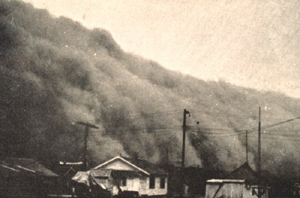
Eight years of drought, of dust storms of epic proportions, record heat, of futile efforts to seal homes from dust so fine it got everywhere, in people’s food, skin, lungs, of days turned to such darkness you could not see further than a few feet and at worst, not even the hand if front of your face.
Birds flew away until they dropped from exhaustion and were covered up in billowing dust.
People who had survived through the Spanish flu had to wear masks again, this time to keep the dust out, which could not be stopped, slowly suffocating out there in the open.
The plains were becoming a tomb, impossible amounts of dirt lifted hundreds of feet up into the sky and swept across the land, burying everything, killing man and beast alike.
Plagues of locusts and swarms of jack rabbits left nothing behind.
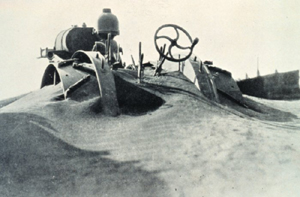
Children dreamed of the rabbits’ screaming as they were culled on Sundays with sticks and rods.
Static electricity generated by the storms was powerful enough to knock men down if they shook hands. People got to wearing gloves, along with the masks. Cars drug chains tied to their rear bumper in order to ground the vehicles. In the spring of 1935, winds blew non-stop for 27 days. Near Amarillo, Texas, a crow’s nest was found, made entirely of pieces of barbed wire, the only material to be found by the bird. Some folks went mad. Some suffocated while others succumbed to dust pneumonia. There were murder-suicides.
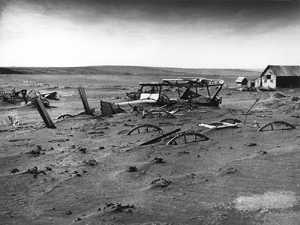
Towns put up signs warning those who’d left the Plains to keep moving on as they couldn’t take care of their own.
And yet, whatever lessons there were to learn were not, by and large. The three horsemen of the terrible thirties will ride again.
The above section was written by Lastech. The section below was written by Rudha-an.
Credit for the first two pictures goes to National Oceanic and Atmospheric Administration/Department of Commerce and the collection can be found here by using the search function. http://www.photolib.noaa.gov/index.html
The Worst Hard Time: The Untold Story of Those Who Survived the Great American Dust Bowl by Timothy Egan tells the personal and sometimes painful stories of several people who survived the Dust Bowl. This book puts a very human face on this ecological disaster. It won the 2006 National Book Award for nonfiction.
This book gets 5 claws
Surviving the Dust Bowl is a part of the PBS series “American Experience”. While not a great documentary, it makes a good companion piece to the Timothy Egan’s book above. Several of the people interviewed were featured in the book. Warning, there is footage of the rabbit culling that can be rather disturbing.
This documentary gets 3 beans.
Last, but not least, we leave you with a song by Woody Guthrie. Guthrie grew up in OK, and was living in the Texas panhandle when the storm that gave the Dust Bowl its name occurred. It happened on April 14, 1935 and it was so huge that many people believed it was the end of the world. It was known as Black Sunday. Woody recorded this song for the Library of Congress. The real name of the song is “Dusty Ole Dust”.
The more I read on Sphynxes, the more I get to understand how typical Mazuzu Whang is… I’m beginning to think of him as our Sphynxy-pooh.
Now a brief word before I continue, to encourage you to play some “golf” and hit some links: check out our blogroll and links on the right for cat and media stuff. We all need the traffic and your comments are always welcome.
Where was I? Yes. I came across this:
sphynxforum (requires membership)
And it was comforting to know Mazuzu’s butt-in-the-face wake up call is not of his own invention. It appears these cats need a back up alarm like trucks, so any inventors out there, take note..!
I’d wondered how to tackle this subject but now I realize I’m not alone, I’ll try to ‘splain.
Mazuzu maneuvers in strange ways… When I reach out to pet him, instead of leaning into my hand, he will back up. Without looking of course.
His tail is always up like a whip antenna, which I gather is a sign of contentment, and yes okay, I’m grateful for that, butt…. (pun intended)
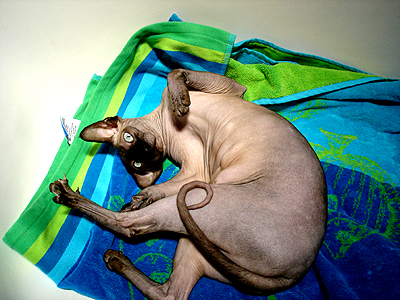
That means he, ummm, “contacts” places and things I wish he wouldn’t. I’ve learned to reach from the side and give his flank some scritches to foil the dreaded maneuver.
In a previous post I mentioned it’d be good to stock up on baby wipes, because that butt is gonna need the occasional “once over”.
As in when we give Mazuzu a bath, he straightens out his legs, toes splayed up, knowing his nether regions are going to get cleaned, and I can read his expression:
“Ye gads! NO! GOD NO! Stay away from there!”
But we’re done before he knows it…
Now, before I got used to his “antics”, meaning I learned to sleep with one eye open, the infamous plug incident happened.
On this particular night, I felt him stir between us. Didn’t realize he was moving.
I opened an eye.
My brain tried to make sense of what was happening.
I tried to make out his face but that wasn’t what I was seeing. Before I could even begin to understand, he shoved his butt up my right nostril.
I-was-breathing-in…
I compensated for my stomach beginning to heave by accelerating towards the bathroom at warp 9 point 8, grabbed the hand-washing soap, upended it and squirted up my nose, resulting in pain beyond the worst brain-freeze I ever felt.
Once it all became clear, my wife couldn’t stop laughing and Mazuzu stopped licking his extended hind leg to look at me as though I was crazy.
I’d rather have locked lips with a jumping crocodile. So beware the butt-in-the-face wake up call…
“Rogue” – (99 minutes, Australia 2007)
Somewhere deep in Australia’s Northern Territory, a group of tourists embarks on a tour boat piloted by guide Kate Ryan (Rhada Mitchell). As they prepare to turn back in the late afternoon, the group notices flares going up somewhere deep in sacred aboriginal land.
Reluctantly, they push on in search of the distressed party.
As they consider returning to town, in a wider part of the river forming a lake with a tiny mud island at the center, they come upon a small boat partly submerged and nothing else. Before they have a chance to discuss their next move, their boat is almost lifted out of the water by a huge crocodile hitting them from below.
With the hull breached and rapidly taking water, Ryan steers towards the island and beaches the craft.
With the tide rising and ill-equipped tourists far away from civilization, the group’s survival comes in serious doubt, especially as the huge crocodile begins to pick them off in an inexplicable display of aggression.
Watch the trailer:
Director Greg McLean describes “Rogue” as an old style horror film and I suspect he refers to his suggestion of violence rather than graphic displays. In fact “Rogue” uses both and it’s a good blend. Some reviewers took issue with the pacing, others with a perceived lack of gore. There are several things which set “Rogue” apart from other entries in the so-called killer-croc sub-genre.
One of these are the locations. The setting of the film, the Northern Territory, is one of the main characters, absolutely stunning from the features of the landscape, waters, sky and shifting colors beautifully captured by Will Gibson, the director of photography. Sadly, he passed away in March 2007, and from what I’ve seen in the extras and the way he shot the film, I’m sure he must be dearly missed.
Anyone who loves the outdoors owes it to themselves to check out “Rogue”: footage of this quality and of this part of the world is all too rare.
The music score, written by Frank Tetaz, is excellent: while I was always aware of it, I never felt it intruded, as others have.
The extras have him describe how he integrated certain tonalities to not only ‘support’ the action and mood but define characters: tapping strings on violins and violas, using wooden and metal containers immersed in water as percussion instruments and a simple piece he composed as a foundation for improvised Aboriginal vocalizations.
Very well thought out, and best: it works great, not unlike the soundtrack designed for “winged migration”.
As mentioned above, McLean effectively ‘suggested’ some of the kills, using clever editing and scene set-up rather than showing people getting chomped. This gave those kills he did show more impact. And those were complex scenes to design, between stunt work, CGI, mechanical crocs and editing. What gore there is has more of an impact, not just because it looked very real, but because there wasn’t that much of it throughout the movie. He had a fairly solid group of actors as well, with some unspoken characterization notes, glances, looks and smiles which actually worked better than much of the dialogue, which was on the weak side.
Where McLean avoided gratuitous gore, he gave in to gratuitous cussing, which was unnecessary and ‘jarred’ a little.
Given the shooting conditions, heat, humidity, flies, having real crocs and snakes around, not to mention spending a fair amount of time in murky waters, the actors pushed themselves. As Michael Vartan, who plays American travel writer Pete McKell, says in the extras, he did not have to act afraid, he was terrified. There is a real element of danger shooting a movie in an uncontrolled environment, especially doing take after take in the water as Sam Worthington had to do, knowing a three meter crocodile had been seen in the area. Sure, there are security guys with rifles around, but as they told the actors: “if we have to use the rifle it’s too late.”
And the mechanical croc head with chomping jaws? You can hear them clamp shut hard in the final confrontation in the crocodile’s lair, as Vartan humorously put it, he ‘peed a little’, you’ll know why once you hear that sound: special effects or not, that mechanical croc head could take a limb off.
This was a work intensive production for sure. The island on which the tour party seeks refuge was man made for the movie, in an artificial (and large) lake. The croc’s lair was a set on a sound stage, and the CGI and animatronics were complex blends of real and digital.
I don’t know how much of a return was made on this movie but it deserves to have done well: it is superior in most respects to others in the genre and I would rank it up there with “jaws”.
“Rogue” gets 5 jellybeans.
Paráklētos, “one who consoles, one who intercedes on our behalf, a comforter or an advocate”
Tito was born in the SPCA shelter, and somehow I think this really increased his survival chances. Big as he is now, he was a watchful little runt at 8 weeks old.
Normally, a cat turns his head to look at something and track it, but Tito’s eyes would look you up and down, as though he felt it wasn’t safe to move much and draw attention to himself.

On his early photos, he seems to “cower” a little, as he did when he was brought in for us to meet, a tiny ball of gray fur at the bottom of a big box.
He had a paranoid look in those kitten eyes losing the last of their cloudiness they have for the first weeks of their life.
Tito just turned 2 last month, and how did he change…

We adopted him as a “transition” cat, once Soza had been diagnosed with Lymphoma. The last two years of Soza’s life were skirmishes with the disease, leaving him at times too exhausted to even eat. We became somewhat proficient at administering fluids subcutaneously between his shoulder blades. My wife would keep me posted on his status while I was at work, and even 150cc marked the difference between another day or the final trip to the vet clinic.
I didn’t want us coming home to empty rooms. That’s what brought us home from the shelter that day.
As much as we learned about the economy of a true fighter like this cat, these months took their toll. This month will be the first year anniversary of Soza’s passing.
Once we got he and Tito introduced, they became fast buddies and spent much time grooming each other, which usually deteriorated in wrestling matches.
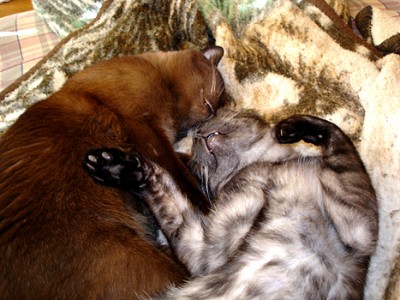
They even had the occasional high speed chase, making Soza as happy as we all could be. But his stamina was diminishing.
Tito didn’t have the chance to be the rambunctious young cat he should have been, especially as he soon outgrew Soza. His routine became regular checks on the older cat, maybe batting a toy around and always, always looking at us inquisitively with his green eyes. He began putting on weight, even though he never over ate, he simply wasn’t getting the exercise he needed.
After the day came, he would roam the apartment, sniffing at Soza’s preferred spots, and when he gave me that questioning look, it twisted something inside.
While Tito never was a lap kitty, Soza used to entice him to curl up on our bed and sleep there. But then that stopped, too. I never fully understood his thing about shoes: he will drop his toys inside our shoes, bat at the laces and generally play with them. But when we put said shoes on, his pupils dilate and he runs away, low to the ground, hiding until they come off.
A couple months passed before we felt it was time for another cat.

We looked for a cat who was social, playful and highly interactive to hopefully make up part of Tito’s lost year. Even writing this, it feels to me as though this column’s again about another cat when it should be Tito’s time to shine. And maybe that’s his lot in life, he doesn’t like the spotlight.
Still, the complete abandon with which he plays with Mazuzu is a joy to behold, as was his expression of disbelief the first few times they chased each other around the house: Tito only wants to run and run forever.
Tito’s made a few posts about cat adoption and other necessary considerations, but I still hear you ask: what’s a Sphynx like..?
Well first off, stock up on Q-tips, cotton pads, baby wipes and a good, chemical free shampoo. Because that sexy body isn’t gonna lick itself to purrfect cleanliness.
Nope, once a week, it’s going to be bath-time and detailing. Oh yes.
Sorry, I had to get that out of the way. These beasties are a commitment and not one you can neglect. But what a return….
I used to think Sphynxes were somewhat fragile, mainly because of how they look. I know: books and their cover. Well, though they kind of have a similar build to Greyhound dogs, built for speed, the buggers are actually pretty sturdy and very strong. They are very good jumpers and fast runners.
Bear that in mind, because you don’t want them to escape out the door when you get home. I’ve read them described as alpha cats who find humans to be the most interesting thing in the house, and in our admittedly limited experience with Mazuzu Whang, I find this to be pretty accurate.

He will rub against our hands and legs, but he ignores the furniture or wall corners. These cats do need company. It’s good if there is another cat or animal for them to play and snuggle with, provided they get along, but they really need human companionship. I don’t mean 24/7, but most of the day, every day, yes.
They would not be good with a single professional, unfortunately. Remember what I said about escaping out the door? A frustrated Sphynx could well try that. And these cats are too social to survive long outside. For that matter, they could be stolen as well. Much like children, you need to know who you let into your home.
Now, I don’t know that it’s a Sphynx trait, but Mazuzu is very vocal: we get a running commentary about how he feels, what he is doing or thinking about doing. I think most of that is directed at Tito because Tito is emulating Mazuzu’s vocalizations. This runs the whole gamut of purring (loudly), chirping, cooing, meowing and clacking his jaws at birds on occasion. A lot of fun actually, because it is so interactive: we have conversations where neither one knows what the hell the other is saying. Still, that seems to satisfy him.
Most pets require patience, and the Sphynx is certainly no exception. It took Mazuzu a while to stop walking all over us with regularity at 4:30 every morning. It is now occasional, but it still can be painful. If a Burmese could be described as a brick wrapped in velvet, a Sphynx is like a mace thinly wrapped in leather. Mazuzu does not tread lightly. Sphynx cats are very physical: when they rub against you, you will definitely feel it. When they nudge you to be petted, likewise you will have no doubt.
But when they play, as Mazuzu and Tito chase each other, Mazuzu often comes in at full speed and jumps on one or both of us, and I’ll say this: it’s kind of close to being hit with a bat! So yeah. Patience. Patience and stamina: you’ll need them.
The rewards of sharing space with a Sphynx are simple. They are one of the smartest, most intelligent and human centric breeds I know about. When we went to introduce ourselves to him last December, about three other Sphynxes were present, along with their human family. It’s a bit difficult to describe the experience, but the closest I can come to is to say it felt like we were in Jurassic Park.
There was animal intelligence all around us, gauging these unknown humans.
These cats just moved nimbly and very gracefully around us, the queen mother planting herself on the table, sitting in front of us, and every one of them making full eye contact. And those eyes were inquisitive and playful.
They came and went, close enough to get a caress and moving on… Mazuzu, brat that he is, at one point came in at a run from the hallway and deftly climbed up the drapes. He now does the same thing on the cat tower we have at home, and still leaps like a flying monkey. There’s a piece of me that’s still back there in that living room: the buggers stole it.
Leonardo da Vinci was quoted as saying “the smallest feline is perfection”. As we watch Mazuzu, whether at rest or in motion I really wonder what he would have thought about Sphynx cats. They are simply fascinating. Just be prepared to make room for them in bed: they won’t be denied…
And watch your dinner: they eat easily twice as much as other (furred) breeds to maintain their body temperature. Plus they burn a lot of energy playing. They’re not above sampling your food, whether or not you’re looking, or whether it’s even good for them, so be careful and grow eyes in the back of your head..!
“Inglorious basterds” – (153 minutes, USA 2009)
By now, most everyone reading this is likely to know what this movie’s storyline(s) is (are): a group of Jewish American soldiers led by Lt. Aldo Raine (Brad Pitt) operating in occupied France during WWII, spreading terror amongst Germans, by using unconventional methods. Scalping, beating with baseball bats, etc.
There is another arc involving Shoshanna Dreyfus (Melanie Laurent), sole survivor of a Jewish family hiding at a neighbor’s farm in France, massacred by colonel Hans Landa (Christopher Waltz) and his men.
Both arcs converge towards a final conflagration at the cinema run by Dreyfus under a different name toward the end of the war.
Watch the trailer:
There have been times, in other films, when Quentin Tarantino had me laughing out loud, or really involved in the action. He reportedly said he would be interested in directing a James Bond film, and I would look forward to that. But there are enough issues with “inglorious basterds” that I wish I could have the 2 ½ hours from my life back.
It’s actually closer to 3 hours, seeing that I had to replay certain scenes as it stopped making any kind of sense to me.
I read in some critical reviews that the violence and brutality was such that the reviewer(s) felt sorry for the German soldiers. The scalping of dead soldiers? The beating to death of another with a baseball bat? Really? This points to a failure on both parts, to me: let’s remember German troops decimated entire villages in countries they occupied in retaliation for attacks by resistance movements. “Inglorious basterds” shows precious little of that, however.
Tarantino’s depiction of what the basterds did does not begin to equal what the Gestapo and SS did by a long shot. But then, perhaps some people draw a distinction he does not between the Wermarcht and the SS and Gestapo. No matter.
Eli Roth I felt was miscast as Sgt. Donny Donowitz, “the Jewish Bear”. The actor playing Hugo Stiglitz would have been better. But then Brad Pitt and his inconsistent accent (his character is supposed to come from Tennessee) wasn’t all that inspired either, actually looking… Constipated throughout. There is a saying about grabbing the viewer/reader’s attention right off the bat (no pun intended), with the first scene or lines of a film or book.
The first chapter of “inglorious basterds”, since Tarantino decided to use the chapter format again, introduces Hans Landa, during his “visit” of a French farm, looking for a Jewish family in hiding. The dialogue is well written, Christopher Waltz delivers the lines well, but it’s clearly not the best scene Tarantino’s ever written, and it probably would have benefited from more close up shots.
As it is, I feel that what Tarantino was going for was for the audience to see Landa as a boa constrictor, slowly coiling around the farmer he questions, until he squeezed truth and tears out of him.
As a display of psychological violence, I found it lacking in that the scene did go on too long, and that Waltz as Landa lacked any form of “glee” that I could recognize. Hannibal Lecter, he’s not. Far from it. It felt to me as though Tarantino was actually holding his punches, perhaps because the material was rooted in history, and I suspect, Tarantino actually may be burnt out on violence not just in its physical forms but also in its psychological aspects. Some of you I hear go: “What-the-f***?!?”
Here I suspect there may have been more conflict off screen than on.
“Inglorious basterds” opening scene also features music by Ennio Morricone, and as the movie is intended as an homage to Spaghetti Western, that would seem to make sense. Except I began to disconnect right then and there instead of being pulled in. It didn’t belong there. I didn’t time how long it took Landa and his men to reach the farm, but I had to get up and start a pot of coffee.
And so it went on and on and on.
Tarantino I think gets blamed and praised for the same reasons: his reverence and references to the movies. And many of the reviews I’ve read of “inglorious basterds” tend to swing between extremes. I do wonder whether this film is a turning point for him, seeing how he wrote the two female characters (Shoshanna Dreyfus and Bridget Von Hammersmark, played by Diane Kruger) and what happens to them…
As it is, I hope his next choice of material will suit him better. If you’re even on the fence about Tarantino, skip this one, and watch, say “army of shadows” by Melville instead. But if you’re a fan… Well you’ve already seen and loved “inglorious basterds” by now, haven’t you?
I’m giving “inglorious basterds” one jellybean for ambition.
We have a busy month ahead, with the usual features plus additional reviews of books (“the worst hard time” and “the worst journey in the world” for instance).
We’ll also revisit the old(ish) TV series “Friday the 13th”, which ran from 1987 to 1990, as well as “the human centipede”, “rogue”, “the horseman” and more…
A good way to celebrate the fall.
“Dark portals: the chronicles of Vidocq” – Reflections before the lights (98 minutes, France 2001)
“One man struck by lightning is an accident. Two men struck by lightning is a conspiracy.”
Word of advice: the dubbing is pretty bad on this one, so you may well want to listen to the French soundtrack with English subtitles… And dark as the movie is visually, you’ll want to wait after Midnight.
Paris in 1830, capital of a country in turmoil, with a regime installed by the Prussians. Francois Vidocq (Gerard Depardieu), former creator and head of Napoleon’s secret police, sacked under the current government, is now France’s most famous detective.
Someone has been killing French notables with no discernible link between them, stumping the chief of Parisian police. Worse yet, the assassin used lightning to set them ablaze!
Hot on the mysterious killer’s trail, Vidocq chases him into a glass factory. Deep into the bowels of this place, Vidocq fights this “Alchemist”, as he is known, who seems possessed of super-human abilities, with stamina and acrobatics which Vidocq cannot match. And indeed, the detective falls into a furnace pit, seemingly to his death.
As the paper men all over Paris shout that Vidocq is dead, his former partner Nimier (Moussa Maaskri) receives an unwelcome visit from young journalist Etienne Boisset (actor-film maker Guillaume Canet), who claims to have worked with Vidocq on his biography. Boisset now is intent on discovering everything about Vidocq’s last case, the pursuit of the Alchemist.
In flashbacks, we retrace the steps which led Vidocq to the glass factory, through the darkest chambers at the heart of the City of Light, and the hellish plot the “victims” were involved in.
This is an interesting story with layers. Vidocq is part of French history, a former convict, whom Napoleon did in fact utilize to great effect in reforming French police. That in itself is worth researching. This film has an interesting look and atmosphere as well, part video game, part graphic novel, dark with vivid colors, shot entirely in digital with Sony’s 1080 p, 24 fps camera before even Star Wars episode II.
Written and directed by Pitof, “Chronicles of Vidocq” also profits from Marc Caro’s character design. Caro used to collaborate with Jean-Pierre Jeunet on comic strips and “City of lost children”. Bruno Coulais’ music suits the mood perfectly as well.
This is a dark tale, which will put viewers in mind of “from hell”, though very distinct. A lovely trip to take past midnight.
“Dark portals: the chronicles of Vidocq” gets 4 jellybeans.